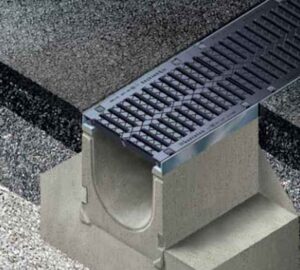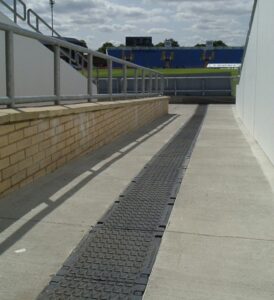Channel drainage, also known as trench drainage, is a type of building drainage which helps remove surface water away from gardens, patios and driveways, thereby preventing flooding and any overspill.
What’s more:
It also does a great job of controlling water flow by relieving the pressure on the drainage system.
But in order to do so consistently and efficiently, your drain channel needs to be cleaned on a regular basis – especially during the rainy season when it often tends to get clogged.
So, how do you unclog a trench drain?
Read on to find out.
Table of contents:
How to clean channel drains
Cleaning your grill drain is quick and easy. All you’ll need to do the job is a few simple tools.
They are:
- Screwdriver
- Drainage hook (can be substituted with a sturdy clothes hanger)
- Dustpan & brush
- Bucket
- Trowel
- Hosepipe
Once you’ve assembled everything, you’re ready to go! Simply follow these steps.

Step 1: Lift off the storm drainage channel cover
This sounds straightforward enough. And depending on the model, it usually is.
But in certain cases, you’re probably wondering:
How do I remove a channel drain cover?
Here’s the deal:
Channel drainage solutions often use keys, bolts, screws or even more complicated locking systems to secure the grate to the channel. If you’re not sure which type yours is, it’s best to refer to the manufacturer. This way, you’ll avoid any unwanted damage.
Once you’ve unlocked the grate successfully, use the drainage hook or hanger to carefully lift the cover from one end. Remove it completely and set it aside.
Keep in mind that these are often quite heavy, so don’t rush it!
Step 2: Clean the body of the channel
Using the trowel, remove any leaves and small twigs that may have made their way inside and place them in the bucket. All this can go in the compost later.
Then, go to work with your trusty brush and dustpan to get rid of finer dust and debris.
Step 3: Clean the sump unit
Most channel drainage solutions feature a sump unit at the end of the channel. Basically, it acts as a filter by stopping any debris from going into the storm drains.
Once you’ve located it, proceed to carefully take out the sump unit. Empty and clean it just like you did the channel body before replacing it.

Step 4: Rinse the channel body
Use your hosepipe to thoroughly rinse the body of the channel and remove any silt.
Pro tip: Don’t use high pressure if your grating is plastic, as you might damage it.
Step 5: Replace the channel cover
Slowly put the grill drain cover back into place, one length at a time. Step on it to apply some pressure and allow it to snap firmly into place.
Finally, lock the channel.
Voila! Your channel drainage is back in business.
The bottom line
Channel drainage is easy to maintain and has a long service life.
If you’d like to find out more about how it works, we have a handy guide on that!
Or perhaps your drain channel has seen better days, and it’s high time you bought a worthy replacement?
Make sure you check out our article on How to select the right channel drain so you can make an informed purchasing decision.
Let us know if you found this guide useful.





